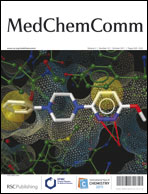This month sees the following articles in MedChemComm that are in the top ten most accessed:
Intramolecular hydrogen bonding to improve membrane permeability and absorption in beyond rule of five chemical space
Alexander Alex, David S. Millan, Manuel Perez, Florian Wakenhut and Gavin A. Whitlock
Med. Chem. Commun., 2011, 2, 669-674
DOI: 10.1039/C1MD00093D
Molecular obesity, potency and other addictions in drug discovery
Michael M. Hann
Med. Chem. Commun., 2011, 2, 349-355
DOI: 10.1039/C1MD00017A
Chemical space as a source for new drugs
Jean-Louis Reymond, Ruud van Deursen, Lorenz C. Blum and Lars Ruddigkeit
Med. Chem. Commun., 2010, 1, 30-38
DOI: 10.1039/c0md00020e
Are pyridazines privileged structures?
Camille G. Wermuth
Med. Chem. Commun., 2011, Advance Article
DOI: 10.1039/C1MD00074H
Identification of target family directed bioisosteric replacements
Anne Mai Wassermann and Jürgen Bajorath
Med. Chem. Commun., 2011, 2, 601-606
DOI: 10.1039/C1MD00066G
Designing glucokinase activators with reduced hypoglycemia risk: discovery of N,N-dimethyl-5-(2-methyl-6-((5-methylpyrazin-2-yl)-carbamoyl)benzofuran-4-yloxy)pyrimidine-2-carboxamide as a clinical candidate for the treatment of type 2 diabetes
Jeffrey A. Pfefferkorn, Angel Guzman-Perez, Peter J. Oates, John Litchfield, Gary Aspnes, Arindrajit Basak, John Benbow, Martin A. Berliner, Jianwei Bian, Chulho Choi, Kevin Freeman-Cook, Jeffrey W. Corbett, Mary Didiuk, Joshua R. Dunetz, Kevin J. Filipski, William M. Hungerford, Christopher S. Jones, Kapil Karki, Anthony Ling, Jian-Cheng Li, Leena Patel, Christian Perreault, Hud Risley, James Saenz, Wei Song, Meihua Tu, Robert Aiello, Karen Atkinson, Nicole Barucci, David Beebe, Patricia Bourassa, Francis Bourbounais, Anne M. Brodeur, Rena Burbey, Jing Chen, Theresa D’Aquila, David R. Derksen, Nahor Haddish-Berhane, Cong Huang, James Landro, Amanda Lee Lapworth, Margit MacDougall, David Perregaux, John Pettersen, Alan Robertson, Beijing Tan, Judith L. Treadway, Shenping Liu, Xiayang Qiu, John Knafels, Mark Ammirati, Xi Song, Paul DaSilva-Jardine, Spiros Liras, Laurel Sweet and Timothy P. Rolph
Med. Chem. Commun., 2011, Advance Article
DOI: 10.1039/c1md00116g
Aromatic chloride to nitrile transformation: medicinal and synthetic chemistry
Lyn H. Jones, Nicholas W. Summerhill, Nigel A. Swain and James E. Mills
Med. Chem. Commun., 2010, 1, 309-318
DOI: 10.1039/C0MD00135J
Carbazole‒pyrrolo[2,1-c][1,4]benzodiazepine conjugates: design, synthesis, and biological evaluation
Ahmed Kamal, Rajesh V. C. R. N. C. Shetti, M. Janaki Ramaiah, P. Swapna, K. Srinivasa Reddy, A. Mallareddy, M. P. Narasimha Rao, Mukesh Chourasia, G. Narahari Sastry, Aarti Juvekar, Surekha Zingde, Pranjal Sarma, S. N. C. V. L. Pushpavalli and Manika Pal-Bhadra
Med. Chem. Commun., 2011, 2, 780-788
DOI: 10.1039/c1md00072a
Optimized glucuronidation of dual pharmacology β-2 agonists/M3 antagonists for the treatment of COPD
Laura Hilton, Rachel Osborne, Amy S. Kenyon, Helen Baldock, Mark E. Bunnage, Jane Burrows, Nick Clarke, Michele Coghlan, David Entwistle, David Fairman, Neil Feeder, Kim James, Rhys M. Jones, Nadia Laouar, Graham Lunn, Stuart Marshall, Sandra D. Newman, Sheena Patel, Matthew D. Selby, Fiona Spence, Emilio F. Stuart, Susan Summerhill, Michael A. Trevethick, Karen N. Wright, Michael Yeadon, David A. Price and Lyn H. Jones
Med. Chem. Commun., 2011, Advance Article
DOI: 10.1039/c1md00140j
Matrix-based multiparameter optimisation of glucokinase activators: the discovery of AZD1092
Michael J. Waring, Craig Johnstone, Darren McKerrecher, Kurt G. Pike and Graeme Robb
Med. Chem. Commun., 2011, 2, 775-779
DOI: 10.1039/c1md00092f
Why not take a look at the articles today and blog your thoughts and comments below.
Fancy submitting an article to MedChemComm? Then why not submit to us today or alternatively email us your suggestions.
Comments Off on Top ten most accessed articles in July
![GA[9]](https://blogs.rsc.org/md/files/2011/10/GA9-300x118.gif)
















![CoverIssue[2]](https://blogs.rsc.org/md/files/2011/09/CoverIssue2.gif)